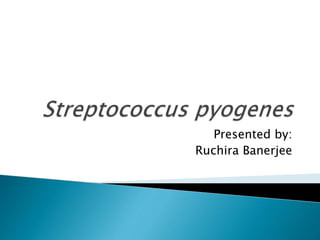
Streptococcus pyogenes
- 2. Hippocrates, also known as the father of medicine was the first to record scarlet fever in 4th Century B.C. Fehleisen, in 1883, made it clear that the causative agent of rheumatic fever, scarlet fever and strep throat is same Rosenbach named it Streptococcus pyogenes in 1884 Pasteur first isolated this chain forming bacteria in 1879
- 3. Gram positive, non motile, non spore forming coccus that occurs in chains or pairs of cells Metabolism is fermentive Facultative anaerobe Requires enriched medium containing blood to grow properly Only species under Lancefield's group A Streptococcus One of the most common pathogen in human disease
- 4. Virulence factors are categorized as cell wall antigens, toxins and enzymes Cell wall antigens The cell was is composed of three layers; the inner thick peptidoglycan layer, middle layer of group specific C-Carbohydrate antigen and outer protein and lipoteichoic acid layer In the outer protein layer three protein antigens are observed; M, T and R proteins Pilli is also present Capsulated
- 5. Toxins Hemolysins: Streptococci form two hemolysins; streptolysin O, which is an oxygen liable streptolysin which means that the streptolysin is inactive in its oxidized form but can get activated on treatment with some mild reducing agents and Streptolysin S which is an oxygen stable hemolysin that is responsible for the hemolysis seen around the streptococcal colonies on the surface of blood agar plates
- 6. Streptococcal Pyrogenic Exotoxin: Also known as erythrogenic toxin because it produces erythematous reactions in the skin which is used to identify scarlet fever Streptokinase: Also known as fibrinolysin, promotes the lysis of human fibrin clots by activating a plasma precursor Deoxyribonucleases: Responsible for the depolymerisation of the DNA. The Dnases are antigenically distinct DNases A, B, C and D, out of these type B is most antigenic in human beings
- 7. Nicotinamide Adenine Dinucleotidase: It acts on the coenzyme NAD and liberates nicotinamide which is antigenic and specifically neutralized by convalescent sera Hyaluronidase: It breaks down the hyaluronic acid of the tissues which favors the spread of infection in the intercellular spaces Serum Opacity Factor: Some types of S. pyogenes produce lipoproteins that creates an opacity when applied on agar gel containing horse or swine serum. It is a virulence determinant of the organism
- 8. Streptococcus pyogenes is responsible for two major respiratory tract disease. Throat is the primary site where the invasion occurs and the infection occurs through respiratory droplets. The diseases caused are: Pharyngitis Scarlet Fever
- 9. Also known as Sore throat Most common streptococcal disease Either in localized form or in diffused form Characterized by erythema and swelling of pharyngeal mucosa with pus secreting exudate formation Children less than the age of 3 years are manifested with a syndrome of fever, malaise and lymphadenopathy without exudative pharyngitis
- 10. Pharyngitis gets complicated when the infection spreads from the pharynx to deeper tissues by direct When the infection spreads through hematogenous or lymphatic routes, it leads to diseases like sinusitis, meningitis, bacteremia etc.
- 11. Also known as Scarlatina Mainly affects children between the age of 5 years to 15 years Earlier it was a very common childhood disease but now has become rare It is a contagious disease that can spread even through touch Mediated due to streptococcal toxins SPE-A, B, and C
- 12. Major characteristic is pharayngitis Bright red rashes on skin having a sand paper like texture Rashes are either due to direct action of the circulating toxin or due to hypersensitivity reaction Strawberry tongue i.e., a tongue with large red dots Rashes in skin folds known as the Pastia’s lines
- 13. Specimen Collection and Transport: Solely depends on the site of the lesion but generally the specimens are collected from throat swab, pus swab, exudates and blood Specimens are immediately transported after collection or plated on Pike’s transport media which consists of blood agar with crystal violet and sodium azide
- 14. Direct Smear Microscopy: Gram staining of pus swab shows gram positive cocci in chain In case of using throat swab direct microscopy is not much useful because in that case Streptococcus pyogenes becomes a part of the normal flora in the sample Culture: Blood Agar: Colonies formed as small, pinpoint, circular, semitransparent and with a wide zone of β hemolysis Liquid media: Glucose, serum broth or brain heart infusion broth is used and the growth appears as granular turbidity with powdery deposit
- 15. Selective media: Crystal violet blood agar: 0.1% Crystal violet prevents the growth of other bacteria and promotes only the growth of S. pyogenes PNF media: Composed of horse blood agar with polymyxin B, neomycin and fusidic acid. These antibiotics do not allow other microorganisms to grow Biochemical tests for identification: Catalase test: This test helps in differentiating between catalase positive and catalase negative bacteria where, streptococci are catalase negative
- 16. Bacitracin sensitivity testing: This test helps in differentiating between group A and group B Streptococcus. The group A Streptococcus are sensitive to bacitracin 0.04 U disk whereas the group B Streptococcus are resistant to it. Any zone of inhibition around the disk is considered as a positive test. It can be used as a rapid diagnostic test for Group A Streptococcus
- 17. All the beta hemolytic group A streptococci are sensitive to penicillin G Majorly sensitive to Erythromycin Patients allergic to penicillin G and Erythromycin are treated with Cephalexin Tetracyclines and sulphonamides are not recommended at all Bacitracin is used for local application on skin lesions